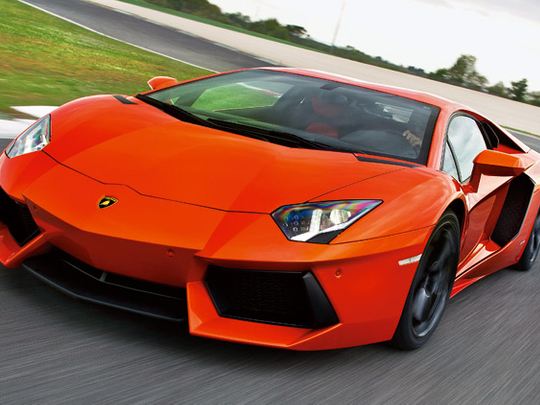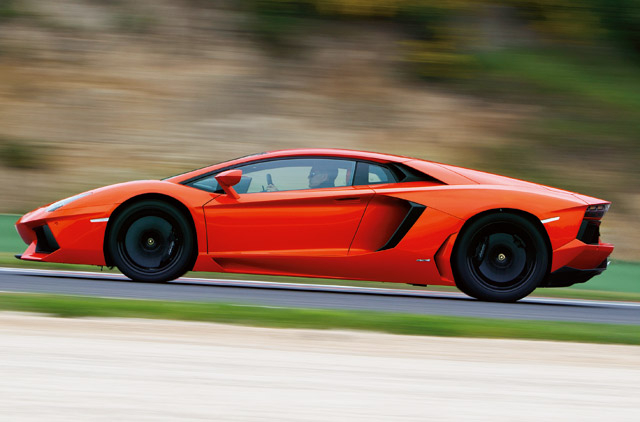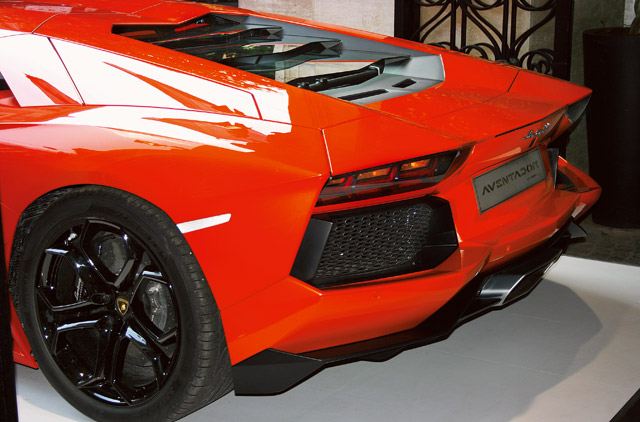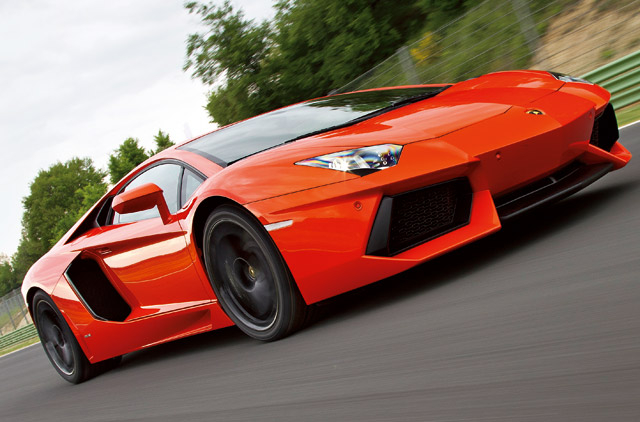
Zero to 100kph in 2.9 seconds — the first proper car to break the three-second barrier. It is also one of the first production cars with a carbon-fibre monocoque. Powered by a 700bhp motor and driving through a superb seven-speed transmission, you also enjoy all-wheel drive, F1-style pushrod suspension and more. Audi investment has enabled Lamborghini to take an enormous leap forward — "a two-generation leap" were the words of CEO Stephan Winkelmann.
The Aventador LP 700-4 is the first all-new Lamborghini since the Gallardo in 2003. Lamborghini chose
Despite a clean sheet of paper, in-house designer Filippo Perini has retained the Lamborghini DNA in that if you covered the badge, the Aventador — named after a fighting bull — still looks like a Lamborghini. The company's brilliant technical director, Maurizio Reggiani, told me a long time ago that power-to-weight ratio will become a priority — the Aventador is proof. Lamborghini has always been radical; the first company with a transverse V12 (Miura), and one of the first with a V12 mid-engined AWD car (Diablo).
A few years ago when it looked like supercars were heading for extinction, Lamborghini continued unabated. Despite recessions and fuel crises, the supercar, hypercar, supersports car market — cal it what you will — is rampant with models from McLaren, Pagani, Ferrari,Koenigsegg and Bugatti. It was fellow scribe LJK Setright (1931-2005) who first penned the term ‘supercar' — and it was for the Lamborghini Miura.
You might have thought that the 150th birthday of Italy would have the whole country celebrating, but the only time Italians wave the tricolore is for the football World Cup, or if a red car winsa Grand Prix. Many Italians regard the State as the enemy. Their home town and family are more important than nationalism.
You may wonder what happened to the people that created the
Technical lesson
Let's start with structure. The centre tub is made from carbon fibre. This is lighter than aluminium, 150 per cent stiffer, and three times better at energy absorption. Attached to the carbon monocoque are two aluminium chassis; one at the front and one at the rear. Bolted to these are the suspension and power train. The aluminium pushrod suspension with Öhlins dampers nestle amidships, thereby reducing unsprung weight.
A button on the dash lifts the nose for negotiating obstacles, the car then drops down automatically to its correct ride height as speed rises.
Unlike the old V12, the all new 6.5-litre V12 is very much a screamer with a bore and stroke of 95mm x 76.4mm. Compared with the outgoing Murciélago 670-4, power is up by 8 per cent, torque by 4.5 per cent, while CO2 is down by a fifth.
The new power characteristics have necessitated a new transmission. The AWD Haldex seven-speed transmission has five operating modes and drives via a twin-plate clutch. For the easy life, the driver can choose Strada-Auto or Sport-Auto. For a busier life there are three paddle shift options: Strada, Sport or Race. Each option changes the shift speeds and characteristics, as well as steering assistance, ABS and rear spoiler angle. The race option, apart from delivering a 50-millisecond sledgehammer shift, also incorporates launch control for the ultimate in standing starts. Finally there is the ESP button; switch off this traction control and you will be flying the Starship Enterprise without the computer.
All the usual top-end luxury creature comforts have been retained despite the relatively low weight of the Aventador. Rear visibility through the slatted rear screen reminded me of my Miura days, while the door mirrors gave excellent rearward visibility. Reverse manoeuvres were aided by a camera and screen.
Huge, bomb-proof carbon brake discs are standard, complete with smart ABS, which brings us to the test drive.
A bull on heat
The Autodromo di Vallelunga is just north of
The scissor doors looked cool as well as aiding access. The electrically adjustable leather seats and dramatic interior oozed quality. There were two display screens: one dead ahead for technical info, and one in the centre for climate control, rear camera view, sound system, navigation and so on. Although digital, the displays appeared analogue and therefore user-friendly.
The starter button was under a small red-hinged cover — race style. Engine response was hair-raising. Far too noisy for most race circuits, this level of noise is just about legal on the road.
I clicked the right paddle back and watched first gear show up on the display. I increased throttle for a gentle take-off and was impressed by how the twin-plate clutch made an easy job of a task that used to be a problem with similar robotised systems.
Once clear of the pit lane, and with my head against the headrest, it was blast-off time: 0-100kph in 2.9 seconds (ouch!),0-200kph in 8.9 seconds (gulp!), 0-300kph in 24.5 (OMG!). That would be assuming a long enough straight…
The steering response is superb and nicely geared high. It is 2.7 turns lock-to-lock and comes with an impressive 12.5m turning circle. I always use my left foot for braking in a two-pedal car — just like you do down at your local go-kart track. The Aventador is a car that really flatters an average driver. You can brake hard, deep into your turn-in phase; the ABS will take care of you if you overdo it. The brake pedal is not used just for stopping the car. Applied appropriately it helps to ‘rotate' the car, so that when you clip your apex, the car is at the correct attitude — or tangent, if you want to be technical. Corner exit traction is immense; although with the ESP activated, you don't realise what massive assistance is going on behind the scenes. Again this turns Average Joe into Super Joe. But don't let you lull that into a false sense of security. Beyond that wall of electronics lies a big, scary beast.
For the highest mid-corner speed, a very smooth steering style is required. After a while I started to use a rough steering style to see what happens, and again. The ‘looseness' that ensued was so easily controlled, but it's still not a car for the ham-fisted.
I soon dispensed with Auto modes and the manual Strad a paddle shift mode, and settled into Sport mode. Yet again I was astonished at the improvement. This Haldex system works beautifully and the car really came alive. Sport mode shifts more torque to the rear wheels. This in turn gave the front wheels less to do, so the steering became even more accurate; lovely. Into Race mode and the Law of Diminishing Returns appeared. Yes, things were happening quicker but comfort was now being compromised, especially by the violent gearshifts.
I switched back to Sport and continued tearing up the Vallelunga track. Hairpin turns are killer for any car over 500kg.At 1,575kg dry weight and with AWD,the Aventador was in its worst possible environment. Constant tight 180-degree hairpin turns are spiteful, understeer-inducing things. How the Aventador coped was directly proportional to the freshness of the Pirellis. Overwhelming the front tyres simply won't happen in the real world.
However, what was not tested was how the Aventador would cope with rough roads. Its AWD may even come in useful for UAE sand. While the ride was impeccable on Vallelunga's 4km billiard table, we will have to wait for a road test to see what happens on bumpy surfaces. This is where the race-style pushrod suspension might be surprisingly useful, as the reduced unsprung weight should allow the wheels to travel up and down quicker, without oscillating the cockpit. Add to this that the stiffer chassis permits the use of softer springs; and we may be pleasantly surprised.
Verdict
Supercars (and motorsport) pioneer advanced technology. It is their efficiency that delivers their dramatic statistics. Advanced efficiency inevitably filters down to everyday life. The supercar also generates interest in the young and is an important element in the free-market economy. It adds spice to the motoring world. Without these radical machines we would all be driving Trabants.
Everyone knows that the Aventador will be driven mostly at low speeds on fashionable boulevards by owners who have average road-driving skills. We all know this: you, me, the engineers, the designers, the test drivers, the onlookers, the buyers, everyone. It matters not. Just as you don't pull 1g cornering or 1g braking in your everyday car, so the Aventador will creep about with just the briefest bursts of high-g action. You don't need an atomic wristwatch studded with diamonds, but if that is what turns you on, then why not?
With the driving over, Winkelmann quizzed me. My words to him were, "Great car. I wouldn't change a thing."
When the dust settled and upon reflection, I might ask technical director Maurizio Reggiani to tone down that thumping 50ms gearshift when it is in Race mode. But wow, what a car. On the basis that if you are going to buy a wild car, you might as well buy a really wild car — this is it.
Specs & ratings
- Model Aventador LP 700-4
- Engine 6.5-litre V12
- Transmission Seven-speed, AWD
- Max power 700bhp @ 8,250rpm
- Max torque 690Nm @ 5,500rpm
- Top speed 350kph
- 0-100kph 2.9sec
- Price Dh1.45 million (base)

















